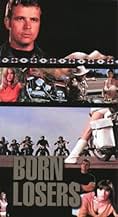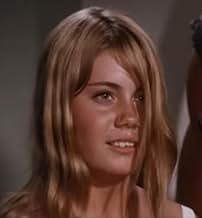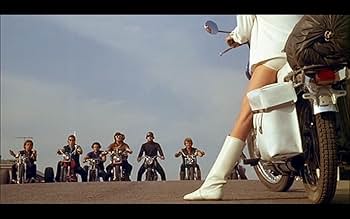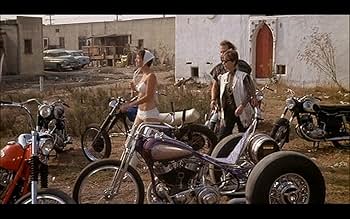AVALIAÇÃO DA IMDb
5,9/10
3 mil
SUA AVALIAÇÃO
Adicionar um enredo no seu idiomaBilly Jack battles a motorcycle gang in a small California beach town.Billy Jack battles a motorcycle gang in a small California beach town.Billy Jack battles a motorcycle gang in a small California beach town.
Robert Tessier
- Cueball
- (as Robert W. Tessier)
Stuart Lancaster
- Sheriff Harvey
- (as Stewart Lancaster)
Avaliações em destaque
Given its low budget, this is not a bad movie. A motorcycle gang, led by the scruffy Jeremy Slate, terrorizes a small California town, and in the process rapes several college girls. There's lots of tough talk, motorcycle noise, and violence, as you would expect for a biker film.
Of course, to balance out all the villainous mayhem, you gotta have a hero on the scene. And for the era in which the film was made, there was no better hero than the charismatic loner, half-breed Billy Jack, played with serene gusto by Tom Laughlin. He's a one-man show of moral and physical strength, as he outwits and outfights the biker roughnecks. The film makes the point that bad parenting and ineptness in traditional law enforcement foster an environment conducive to delinquency.
Interestingly, although this is the first Billy Jack film, Laughlin played a similar role ten years earlier, in a movie called "The Delinquents" (1957). His character was Scotty, a good guy teenager who gets mixed up with a bunch of high school hoodlums. Whereas in "The Delinquents" all the villains are kids who drive around in jalopies, in "The Born Losers", the kids have grown into adults who ride motorcycles.
In "The Born Losers" the characters tend to be stereotypes. In a time period that immediately preceded the women's lib movement, the film's female characters are very, very subservient. The film's plot does depend on contrivances to some extent. Dialogue lacks subtext. Production design is ... colorful. And the costumes reek of late 60's garish "hip" (love those pink walls and pink clothes), all perfectly in sync with the Age of Aquarius. Tom Laughlin's direction is excellent. Color cinematography is very good. The outdoor scenery is wonderful, as is the music in the opening title sequence.
I've seen a number of biker films. "The Born Losers" is one of the best. It was highly successful at the box office, and led to later Billy Jack films. It has a cinematic style that is almost iconoclastic; not insignificantly, it preceded "Easy Rider" by a couple of years. Such was the impact of "The Born Losers".
Of course, to balance out all the villainous mayhem, you gotta have a hero on the scene. And for the era in which the film was made, there was no better hero than the charismatic loner, half-breed Billy Jack, played with serene gusto by Tom Laughlin. He's a one-man show of moral and physical strength, as he outwits and outfights the biker roughnecks. The film makes the point that bad parenting and ineptness in traditional law enforcement foster an environment conducive to delinquency.
Interestingly, although this is the first Billy Jack film, Laughlin played a similar role ten years earlier, in a movie called "The Delinquents" (1957). His character was Scotty, a good guy teenager who gets mixed up with a bunch of high school hoodlums. Whereas in "The Delinquents" all the villains are kids who drive around in jalopies, in "The Born Losers", the kids have grown into adults who ride motorcycles.
In "The Born Losers" the characters tend to be stereotypes. In a time period that immediately preceded the women's lib movement, the film's female characters are very, very subservient. The film's plot does depend on contrivances to some extent. Dialogue lacks subtext. Production design is ... colorful. And the costumes reek of late 60's garish "hip" (love those pink walls and pink clothes), all perfectly in sync with the Age of Aquarius. Tom Laughlin's direction is excellent. Color cinematography is very good. The outdoor scenery is wonderful, as is the music in the opening title sequence.
I've seen a number of biker films. "The Born Losers" is one of the best. It was highly successful at the box office, and led to later Billy Jack films. It has a cinematic style that is almost iconoclastic; not insignificantly, it preceded "Easy Rider" by a couple of years. Such was the impact of "The Born Losers".
While the acting and plot were weak, this movie is worth watching, if only to educate or remind us of the tumultuous 60s... with the ending of the Vietnam War, Hells Angels, drugs-sex-and-rock-n-roll... in a society where returning Vietnam Vets were considered renegades and loose cannons or just plain crazy... in a society where we screamed peace, while resorting to violence... in a society where women's lib was just beginning to surface in the American Consciousness, with the burning of the bras... in a society where the youth of our country cried out against the "establishment", and we "did our own thing"... where altruism flourished along with the rise in cults, crusading preachers, and activism... in a time when man first walked on the moon... when we, as a society believed... nothing at all could stop us. In all, the movie depicted well the general atmosphere of beliefs and attitudes of the times, that, while they might seem moronic to us in today's world, perhaps, 30 years in the future, our attitudes and beliefs will seem moronic to the generations to follow.
The first "Billy Jack" film is a serious examination of rape and personal cowardice disguised as a biker/drug exploitation film. It manages to satisfy on both counts. No nudity, lots of outrageous clothing, and plenty of nazi bikers. Not quite as good as its sequel (which was written previously) but also not so preachy and talky. Dig the "nature carnage" at the film's beginning. Decent photography (marred in the DVD presentation by pan and scan process), but mid to low grade actors. Russell appears as a burnt-out, harried mom. Is she really acting? She's way over the top, but fun as always.
p.s. (2008, second viewing) p.s. the movie isn't going to appeal to everyone, but it's coming from a good place compared to a lot of exploitation films. There's a lot of classic Hollywood here, Tom Laughlin drawing on a lot of his roots. Like "Billy Jack" this movie is a very passionate statement against rape and it condemns society's attitude about rape. But because the victims are so beautiful, frankly the movie feels more exploitative and less serious than the more successful sequel. You could look on this movie as a learning experience for Laughlin, but it's a very interesting drive-in biker movie in and of itself, very different and more carefully put together than a lot of its brethren. For example this time around I noticed that the film can be seen as an anti-Western -- as opposed to the stereotypical concept of a white man rescuing the white virgins from the "indians", here we have an ostensibly Native American hero rescuing the white women from white bikers (bikes and jeeps standing in for horses and stagecoaches in the traditional Western iconography of course).
p.s. (2008, second viewing) p.s. the movie isn't going to appeal to everyone, but it's coming from a good place compared to a lot of exploitation films. There's a lot of classic Hollywood here, Tom Laughlin drawing on a lot of his roots. Like "Billy Jack" this movie is a very passionate statement against rape and it condemns society's attitude about rape. But because the victims are so beautiful, frankly the movie feels more exploitative and less serious than the more successful sequel. You could look on this movie as a learning experience for Laughlin, but it's a very interesting drive-in biker movie in and of itself, very different and more carefully put together than a lot of its brethren. For example this time around I noticed that the film can be seen as an anti-Western -- as opposed to the stereotypical concept of a white man rescuing the white virgins from the "indians", here we have an ostensibly Native American hero rescuing the white women from white bikers (bikes and jeeps standing in for horses and stagecoaches in the traditional Western iconography of course).
This movie is interesting on many levels. Although it contains a few shocking scenes (if viewed unedited) it still comes across as kind of campy. When a girl on a motorcycle p***es off a motorcycle gang the fun begins. First of all, the girl on the cute little scooter type motorcyle looks like she just finished a gig on the "Hullabaloo" TV show complete with her matching go-go boots and bikini. She is kinda cute except she has a haircut that looks like they put a bowl on her head and cut around it. (She could have at least wore a "Bob's Big Boy Cascade" to sex it up a bit). She mouths off to the group of scumbags who all look like rejects from the Manson Family.
One shocking scene for 1967 is the part where two gang members french kiss (they are both men)! This is to illustrate the free-sex attitude of the era and supposedly (I am guessing here) to show what a bunch of degenerates these guys are.
Jane Russell is over the top here as a drunken, floozy mother of a teenage trollop who does a strip tease in her trailer park that has to be seen to be believed. The look on her face while stripping is somewhere between orgasmic and root canal. RENT THIS AND HAVE FUN!
One shocking scene for 1967 is the part where two gang members french kiss (they are both men)! This is to illustrate the free-sex attitude of the era and supposedly (I am guessing here) to show what a bunch of degenerates these guys are.
Jane Russell is over the top here as a drunken, floozy mother of a teenage trollop who does a strip tease in her trailer park that has to be seen to be believed. The look on her face while stripping is somewhere between orgasmic and root canal. RENT THIS AND HAVE FUN!
While most people are familiar with Tom Laughlin's half Native American/half Anglo cult figure Billy Jack through THE LEGEND OF BILLY JACK, many don't know that the character originally appeared in this flick, an off-kilter biker flick about a group of psycho cyclists who terrorize a small California town over Spring Break and zero in on a young college co-ed whom they raped and don't want to testify against them. No, the film isn't as good(or political)as the two sequels, but it does say something about the isolation of the individual in a society that won't stand up and protect that individual from harm. There's a profound sense of solitude in the cinematography of beaches and seaside highways and the sparse, often inarticulate dialog. And, looking closely at the motorcycle gang, you can see some none-too-subtle homosexual overtones. Of course, all the quick cuts and zoom shots earmark the film as a product of late sixties moviemaking. Still, if you want to catch a glimpse of Billy Jack's debut or like to study sixties film styles, take a look at this one
Você sabia?
- CuriosidadesBased on a real incident in 1964 when members of the Hell's Angels motorcycle gang were arrested for raping five girls in Monterey, California.
- Erros de gravaçãoAt the beginning of the scene at the Shorns' house, the LP record Jodell is looking at while talking to her mother changes from David Rose's 'The Stripper' into 'Music to Strip By' and then back again. These were both actual stripper-themed LPs released in the 1960s (perhaps suggesting Mrs. Shorn's previous occupation?)
- Citações
Child: Hey. You don't have a watch on. How you gonna know when fifteen minutes are up?
Billy Jack: Well you better hope that I'm a good guesser, huh?
- ConexõesFeatured in Dusk to Dawn Drive-In Trash-o-Rama Show Vol. 2 (1996)
- Trilhas sonorasBilly Jack's Theme
Written and Produced by Mike Curb
Co-produced by Al Simms
Performed by Davie Allan with The Arrows (as The Sidewalk Sounds)
Principais escolhas
Faça login para avaliar e ver a lista de recomendações personalizadas
Detalhes
- Data de lançamento
- País de origem
- Idioma
- Também conhecido como
- Nacidos para perder
- Locações de filme
- Main Street, Seal Beach, Califórnia, EUA(Biker rally: Irisher [121], Condo's Rock Shop [125], Raines Radio [127], etc.)
- Empresas de produção
- Consulte mais créditos da empresa na IMDbPro
Bilheteria
- Orçamento
- US$ 360.000 (estimativa)
Contribua para esta página
Sugerir uma alteração ou adicionar conteúdo ausente

Principal brecha
By what name was Nascidos para Perder (1967) officially released in India in English?
Responda





























